
The gastric sleeve procedure is an irreversible procedure that is done to help people lose weight. Unlike other procedures that simply create a small pouch for the food to go, this procedure removes the larger part of the stomach completely, leaving only about ¼ of the original size.
There has been a lot of great success with continued weight loss following this procedure, though it is also important to keep in mind the surgery’s potential complications and risks. Here are some of the most important statistics and rates regarding the complications of the gastric sleeve procedure.
About the Gastric Sleeve Procedure
The gastric sleeve procedure, also called a sleeve gastrectomy, is the more invasive weight loss procedures. Like other bariatric procedures, its purpose is to reduce how much food someone can eat overall and speed up how full they feel after a meal. It should help them learn proper portion control and encourage eating smaller meals throughout the day, which also helps with weight loss.
One thing that patients should understand about gastric sleeve is that it cannot be reversed. Approximately 75 percent of the stomach is surgically removed through a laparoscopic procedure, leaving behind only 25 percent of the stomach’s original size.
The Risks and Complications
There are several potential risks and complications for gastric sleeve procedures specifically, in addition to the basic risks with any abdominal surgery and anesthesia-related risks.
Some people are at a higher risk for complications based on their physical health prior to surgery. This is why surgeons want to go through a complete medical history and determine patients’ health before going through with the surgery. There is a low mortality rate for gastric sleeve procedures at just 0.19 percent. Some other possible complications include bleeding, leaks from the incision site, stenosis or strictures, and the development of GastroEsophageal Reflux Disease (GERD).
The Statistics
The four most common complications after having gastric sleeve surgery are bleeding, leaks, stenosis, and GERD. According to recent studies, there were 1.2 percent of patients with bleeding, 2.2 percent of patients with leaks, 0.6 percent of patients with stenosis or strictures, and about 1 out of 5 patients that develop GERD. This is considered a minor complication as it is easily treatable.
Another study showed a total complication rate of about 3.2 percent, which included minor and moderate complications like nausea or vomiting, dehydration, deep venous thrombosis, pulmonary embolism, bleeding, reflux, and cholecystitis. Most studies show a 0-0.19 percent mortality rate, which is very good for what is sometimes considered major surgery. Patients also consider the surgery worth it in most cases, even if they experienced some of these complications.
Comparing Complications to Lap Band Procedure
The main comparison in complications of weight loss surgeries is between the gastric sleeve procedure and lap band surgery. With lap band surgery, the stomach is not permanently altered. An adjustable ring is placed around the part of the stomach, creating a small pocket where food goes. It has the same effect as a gastric sleeve, but the band can be increased or decreased depending on the patient’s needs and success with their weight loss.
With the complications, there are some differences between these two procedures. One difference is that after a gastric sleeve, there is usually a longer recovery time due to the discomfort and swelling following the surgery. There is also a greater risk of blood clots and gallstones with gastric sleeve. These differences are mainly due to gastric sleeve being a major surgery, while lap band surgery is less invasive.
Tips for Preventing Complications
While it can be scary looking at the potential risks and complications after sleeve gastrectomy surgery, there are ways you can reduce your risks. This includes researching your surgeon before choosing them, providing them with a complete medical history and being as detailed as possible, discussing all the possible risks beforehand, and following all doctor’s orders after surgery, whether it is eating, exercising, looking for signs of problems, or attending follow-up visits.
Knowing the potential risks and complications of any surgery, including gastric sleeve, is vital. Always research your doctor and make sure you know their licensing, experience, and their statistics of complications from their patients. After that, follow all their pre-op and post-op instructions, and you have a good chance at avoiding most complications. Your medical history also makes a considerable difference in risk factors for certain complications.
